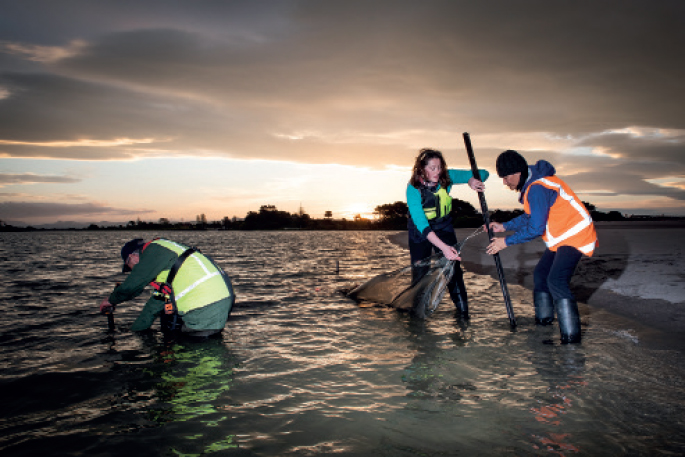It’s 10pm and NIWA trucks are driving along Thornton beach towards the Rangitaiki river mouth, a 10 minute drive west of Whakatane.
At 10:30pm Waikato university masters student, Siobhan Nuri will drop her nets to start collecting glass eels and plans to be at the river mouth until 3.30am.
She’s helped by Eddie Bowman, an environmental monitoring technician from NIWA, her father Niwa Nuri and sister, Sinead Nuri.
The job has to be done at night because that’s when the eels enter the river mouth.
Glass eels are juvenile forms of tuna (eel) that begin life in deep ocean tranches in the sub-tropical Pacific. The eels then drift with ocean currents, eventually reaching freshwater in New Zealand.
Glass eels do not migrate to the same river or stream that their parents come from, says Eddie.
“That would be a big ask.”
If it was the case the eels would form genetically distinct groups in freshwater and there is no DNA evidence to support this.
The eels are 5.5-6.5cm long and are known as glass eels because of their transparent bodies.
Once the eels reach fresh water, they take days to adjust before moving further upstream.
One of the changes made by the eels is that they stop becoming transparent and start to turn darker as they change from a glass eel to an elver.
Siobhan is attempting to unlock some of the mysteries of the shortfin and longfin eel’s migration patterns.
“We’re trying to figure out when the length of migration is and how different environmental variables can effect migration.”
Siobhan and her team put on waders, life jackets and high-vis vests. They flick on head torches and set nets by the river bank. Waders are not only a good way to stay dry but a practical way to keep warm during the wee hours of the morning.
The team is set up for a long night. On the back of one of the NIWA utes lies a spread of coffee, tea and snacks to see the researchers through the night.
There is limited research done on glass eels and the research done has predominantly been done in the South Island. Siobhan is hoping to come up with updated information that’s relevant to the Bay of Plenty and North Island.
Siobhan says the local’s response to the research has been amazing, “every week we get a whole lot of tangata whenua helping us out”.
Siobhan has had schools come visit and she’s chatted to classrooms in the local area about the eels. Classrooms have also run projects focused on tuna inspired from the work her and NIWA have done.
Siobhan took over research started by NIWA last year. She’s been going since June and will finish up next month in December.
Next year Siobhan is hoping to pass on the project to someone else. “We’re hoping to get someone from the iwi to continue the work.”
Siobhan says tuna hold cultural significance to iwi, as well as being a valuable food source.
Tuna are a taonga for Maori and have more than 100 different names for freshwater eels, to describe differences in colour and size.
Many of the glass eels’ secrets hide in its ear bones (otoliths).
“The ear bones are kind of like tree rings.”
Glass eels grow a ring in its ear bone every day and larger, older eels, grow a ring every-year.
Siobhan says the rings provide information on the length of migration and where the eels have been on their migration journey.
Each month 50 longfin and 50 shortfin eels are used for the research.
Catching the eels is not always easy though. Siobhan has done the sampling in all conditions.
“We’ve sampled in heavy rain, hail, big surf, big river flow… there was a sandstorm one night so we couldn’t keep our eyes open.”
A memorable collection night was in June last year, when the first eels should have just started to enter New Zealand’s rivers.
“The literature says that we shouldn’t catch any but we caught heaps.”
The peak migration of the eels is meant to be around October, September and November.
Siobhan says the fact that lots of eels were caught in June is evidence of lack of research done in the area.



0 Comments
Leave a Comment